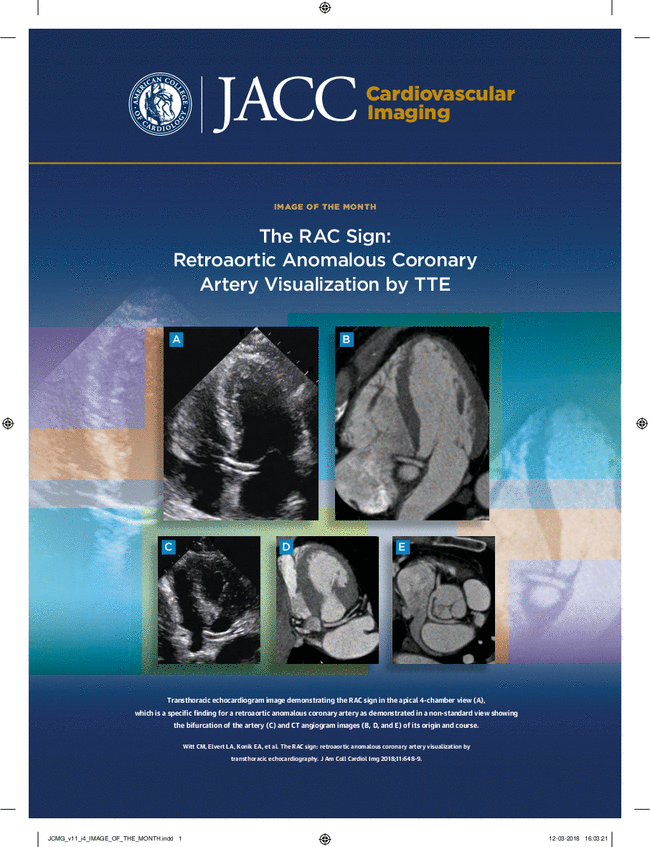冠状动脉粥样硬化患者钙化斑块负担、血管炎症和斑块易损性之间的关系
IF 12.8
1区 医学
Q1 CARDIAC & CARDIOVASCULAR SYSTEMS
引用次数: 0
摘要
背景:冠状动脉钙化是动脉粥样硬化不可分割的一部分。有研究表明,早期冠状动脉钙化与活跃的炎症有关,而晚期钙化则随着炎症的消退而形成。炎症也是斑块易损性的一个重要因素。然而,冠状动脉钙负荷、血管炎症和斑块易损性之间的关系尚未得到充分研究:本研究旨在将冠状动脉病变处的钙化斑块负荷(CPB)与血管炎症和斑块易损性相关联:方法:研究对象包括接受过计算机断层扫描血管造影术和光学相干断层扫描的冠心病患者。作者将患者分为 4 组:1 组为病变部位无钙化;3 组为 CPB 三元组。CPB的计算方法是钙化斑块体积除以病变血管体积。作者比较了4组患者冠状动脉周围脂肪组织(PCAT)对血管炎症和光学相干断层扫描衍生的易损特征的衰减情况:结果:在 578 名患者中,CPB 最高三元组的罪魁祸首血管 PCAT 衰减明显低于其他组别。斑块易损性特征(包括富脂斑块、巨噬细胞和微血管)在 CPB 最高三等分组中的发生率也最低。在钙化患者中,较高的年龄、他汀类药物的使用和较低的 PCAT 衰减与 CPB 独立相关:结论:较大的钙负荷与较低的血管炎症水平和斑块脆弱性相关。结论:较大的钙负荷与较低的血管炎症水平和斑块脆弱性有关,较大的钙负荷可能代表没有明显炎症活动的晚期稳定斑块。(麻省总医院和土浦京东总医院冠状动脉成像协作组;NCT04523194)。本文章由计算机程序翻译,如有差异,请以英文原文为准。
Relationship Between Calcified Plaque Burden, Vascular Inflammation, and Plaque Vulnerability in Patients With Coronary Atherosclerosis
Background
Coronary artery calcification is an integral part of atherosclerosis. It has been suggested that early coronary artery calcification is associated with active inflammation, and advanced calcification forms as inflammation subsides. Inflammation is also an important factor in plaque vulnerability. However, the relationship between coronary artery calcium burden, vascular inflammation, and plaque vulnerability has not been fully investigated.
Objectives
This study aimed to correlate calcified plaque burden (CPB) at the culprit lesion with vascular inflammation and plaque vulnerability.
Methods
Patients with coronary artery disease who had both computed tomography angiography and optical coherence tomography were included. The authors divided the patients into 4 groups: 1 group without calcification at the culprit lesion; and 3 groups based on the CPB tertiles. CPB was calculated as calcified plaque volume divided by vessel volume in the culprit lesion. The authors compared pericoronary adipose tissue (PCAT) attenuation for vascular inflammation and optical coherence tomography–derived vulnerable features among the 4 groups.
Results
Among 578 patients, the highest CPB tertile showed significantly lower PCAT attenuation of culprit vessel compared with the other groups. The prevalence of features of plaque vulnerability (including lipid-rich plaque, macrophage, and microvessel) was also lowest in the highest CPB tertile. In the patients with calcification, higher age, statin use, and lower PCAT attenuation were independently associated with CPB.
Conclusions
Greater calcium burden is associated with a lower level of vascular inflammation and plaque vulnerability. A greater calcium burden may represent advanced stable plaque without significant inflammatory activity. (Massachusetts General Hospital and Tsuchiura Kyodo General Hospital Coronary Imaging Collaboration; NCT04523194)
求助全文
通过发布文献求助,成功后即可免费获取论文全文。
去求助
来源期刊

JACC. Cardiovascular imaging
CARDIAC & CARDIOVASCULAR SYSTEMS-RADIOLOGY, NUCLEAR MEDICINE & MEDICAL IMAGING
CiteScore
24.90
自引率
5.70%
发文量
330
审稿时长
4-8 weeks
期刊介绍:
JACC: Cardiovascular Imaging, part of the prestigious Journal of the American College of Cardiology (JACC) family, offers readers a comprehensive perspective on all aspects of cardiovascular imaging. This specialist journal covers original clinical research on both non-invasive and invasive imaging techniques, including echocardiography, CT, CMR, nuclear, optical imaging, and cine-angiography.
JACC. Cardiovascular imaging highlights advances in basic science and molecular imaging that are expected to significantly impact clinical practice in the next decade. This influence encompasses improvements in diagnostic performance, enhanced understanding of the pathogenetic basis of diseases, and advancements in therapy.
In addition to cutting-edge research,the content of JACC: Cardiovascular Imaging emphasizes practical aspects for the practicing cardiologist, including advocacy and practice management.The journal also features state-of-the-art reviews, ensuring a well-rounded and insightful resource for professionals in the field of cardiovascular imaging.
 求助内容:
求助内容: 应助结果提醒方式:
应助结果提醒方式:


